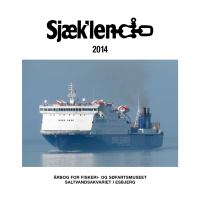

arbejde om bord, måtte de unge selv betale for at være med,
så der sejledes med store besætninger.
I Odense var rederiet således i 1925 tømt for egen skibs-
tonnage købt under højkonjunkturen med høje priser på
brugt tonnage og afhændet med store tab. Så efter blot ti års
virksomhed gled Transatlantic i 1926 over i historien. Mo-
derfirmaet J. J. Larsen i Faaborg oplevede at blive mere end
100 år, idet firmaet først i 1969 likviderede.
13
Noter
1.
Jubilæumsartikel i
Fyns Tidende
2/11 1960.
2.
Ole Mortensøn:
Faaborgs skibsfart 1800 – 1920
, p. 18f.
3.
Kraks blå bog
1923.
4.
Foreningen til Søfartens fremme, jubilæumsskrift 1994,
p. 113f.
5.
Fru Birthe Asfeldt, Herning, takkes for at have stillet fa-
derens utrykte erindringer og scrapbog til rådighed for for-
fatteren.
6.
Nævnte værk bd. 1, p. 255f.
7.
Henning Henningsen: Hurra! Om sømandens hilseskikke
og honnør til søs.
Handels- og Søfartsmuseets årbog
1989.
8.
Kraks blå bog
1933.
9.
Citatet er gengivet efter steward H. P. Hansens rapport til
dombogen for Gøteborg rådhusret. Rapporten er gengivet i
Fra Ribe Amt
1927 og i
Fanø sømænd i storm og stille
bd.
2 p. 215.
10.
Forlisomstændighederne er ligeledes citeret efter
Dansk
Søulykke Statistik
1920, som stort set er identisk med ste-
ward Hansens beretning. Note 9.
11.
Kraks blå bog
1920.
12.
Holm-Petersen m.fl.:
Fra sejl til diesel,
bd. IV, p. 224
samt
Svanesang,
p. 137.
13.
Faaborg Avis
7/2 1969.
Summary
During World War One, Danish grain handling facilities had
difficulty hiring ships to bring supplies of corn and oilcakes
from the American continent. In 1916 the wholesale compa-
ny J. M. Larsen of Odense had to establish its own shipping
business, called Transatlantic, to secure its supplies.
A second hand fleet of six square-riggers was bought
from Norway. These were the barque KYLEMORE of Kris-
tiania, the barque ALEXANDER LAWRENCE of Kristian-
sand, the barque HOLTHE of Larvik (ex BANKBURN of
Liverpool), the full ship OBERON of Porsgrund, the barque
ALBERT HØEG (ex SYVSTJERNE of Sarpsborg) and the
barque HENRY SMIDT (ex EDON of Skien).
On board HOLTHE was the 20-year-old ordinary sailor
Christian Peter Christiansen Kiil (1897-1983) – later for
many years a captain in the DFDS fleet – who in his un-
printed memoirs tells about details of life and circumstances
on board when HOLTHE – contrary to Transatlantic’s inten-
tions – was seized by American authorities and ordered to
participate in the American coast trade.
As long as the war continued, the authorities wanted to
make sure that no part of any cargo exported to Denmark
would pass into German hands. They were very suspicious
of Danish ships, where the crew experienced specific re-
strictions again and again, and dramatic incidents occurred.
Transatlantic was a branch of the grain handling facili-
ties belonging to J. M. Larsen, which was established in
Faaborg in 1860. Even then in the late 1800s the company
got its first experiences as ship owners on a smaller scale.
The Odense branch was established in 1903.
Transatlantic did not gain anything from being self-
sufficient during the war. The fleet, which was bought at
great expense, had to be laid-up in Odense harbour during
the early twenties due to the state of the market. After some
years the ships were sold one by one to be scrapped abroad.
The barque ALBERT HØEG avoided being scrapped.
The ship was wrecked on the Swedish west coast at the en-
try to Gothenburg on returning from its first trip to America.
The KYLEMORE survived some years as the SU-
ZANNE of Marstal, and was later sold to Gustaf Erikson in
the Åland Islands in the Baltic Sea.
In 1925 the Transatlantic Company was without a fleet.
Ships which were bought at great cost during the war were
sold at great losses. After ten years as a shipping company,
Transatlantic was history.
71









